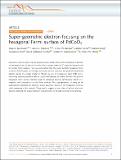Files in this item
Super-geometric electron focusing on the hexagonal Fermi surface of PdCoO2
Item metadata
| dc.contributor.author | Bachmann, Maja D. | |
| dc.contributor.author | Sharpe, Aaron L. | |
| dc.contributor.author | Barnard, Arthur W. | |
| dc.contributor.author | Putzke, Carsten | |
| dc.contributor.author | König, Markus | |
| dc.contributor.author | Khim, Seunghyun | |
| dc.contributor.author | Goldhaber-Gordon, David | |
| dc.contributor.author | Mackenzie, Andrew P. | |
| dc.contributor.author | Moll, Philip J.W. | |
| dc.date.accessioned | 2019-11-22T16:30:03Z | |
| dc.date.available | 2019-11-22T16:30:03Z | |
| dc.date.issued | 2019-11-08 | |
| dc.identifier | 263520168 | |
| dc.identifier | 96c22ef2-8a11-40c3-9b6e-2c5ce7000cb6 | |
| dc.identifier | 85074730221 | |
| dc.identifier | 31705049 | |
| dc.identifier | 000495392700002 | |
| dc.identifier.citation | Bachmann , M D , Sharpe , A L , Barnard , A W , Putzke , C , König , M , Khim , S , Goldhaber-Gordon , D , Mackenzie , A P & Moll , P J W 2019 , ' Super-geometric electron focusing on the hexagonal Fermi surface of PdCoO 2 ' , Nature Communications , vol. 10 , 5081 . https://doi.org/10.1038/s41467-019-13020-9 | en |
| dc.identifier.issn | 2041-1723 | |
| dc.identifier.other | ORCID: /0000-0002-1075-3888/work/65014387 | |
| dc.identifier.uri | https://hdl.handle.net/10023/18990 | |
| dc.description | The project was supported by the Max-Planck Society and has received funding from the European Research Council (ERC) under the European Union’s Horizon 2020 research and innovation programme (grant agreement No. 715730). M.D.B. acknowledges studentship funding from EPSRC under grant no. EP/I007002/1. A.L.S. acknowledges support from a Ford Foundation Predoctoral Fellowship and a National Science Foundation Graduate Research Fellowship. A.L.S. would like to thank Edwin Huang for helpful discussions and Tom Devereaux for letting us use his group cluster. Computational work was performed on the Sherlock cluster at Stanford University and on resources of the National Energy Research Scientific Computing Center, supported by DOE under contract DE_AC02-05CH11231. D.G.G.’s and A.W.B.’s work was supported by the U.S. Department of Energy, Office of Science, Basic EnergySciences, Materials Sciences and Engineering Division, under Contract No. DE-AC02-76SF00515. | en |
| dc.description.abstract | Geometric electron optics may be implemented in solids when electron transport is ballistic on the length scale of a device. Currently, this is realized mainly in 2D materials characterized by circular Fermi surfaces. Here we demonstrate that the nearly perfectly hexagonal Fermi surface of PdCoO2 gives rise to highly directional ballistic transport. We probe this directional ballistic regime in a single crystal of PdCoO2 by use of focused ion beam (FIB) micro-machining, defining crystalline ballistic circuits with features as small as 250 nm. The peculiar hexagonal Fermi surface naturally leads to enhanced electron self-focusing effects in a magnetic field compared to circular Fermi surfaces. This super-geometric focusing can be quantitatively predicted for arbitrary device geometry, based on the hexagonal cyclotron orbits appearing in this material. These results suggest a novel class of ballistic electronic devices exploiting the unique transport characteristics of strongly faceted Fermi surfaces. | |
| dc.format.extent | 8 | |
| dc.format.extent | 3052991 | |
| dc.language.iso | eng | |
| dc.relation.ispartof | Nature Communications | en |
| dc.subject | QC Physics | en |
| dc.subject | Chemistry(all) | en |
| dc.subject | Biochemistry, Genetics and Molecular Biology(all) | en |
| dc.subject | Physics and Astronomy(all) | en |
| dc.subject | DAS | en |
| dc.subject.lcc | QC | en |
| dc.title | Super-geometric electron focusing on the hexagonal Fermi surface of PdCoO2 | en |
| dc.type | Journal article | en |
| dc.contributor.institution | University of St Andrews. School of Physics and Astronomy | en |
| dc.contributor.institution | University of St Andrews. Condensed Matter Physics | en |
| dc.identifier.doi | 10.1038/s41467-019-13020-9 | |
| dc.description.status | Peer reviewed | en |
This item appears in the following Collection(s)
Items in the St Andrews Research Repository are protected by copyright, with all rights reserved, unless otherwise indicated.

